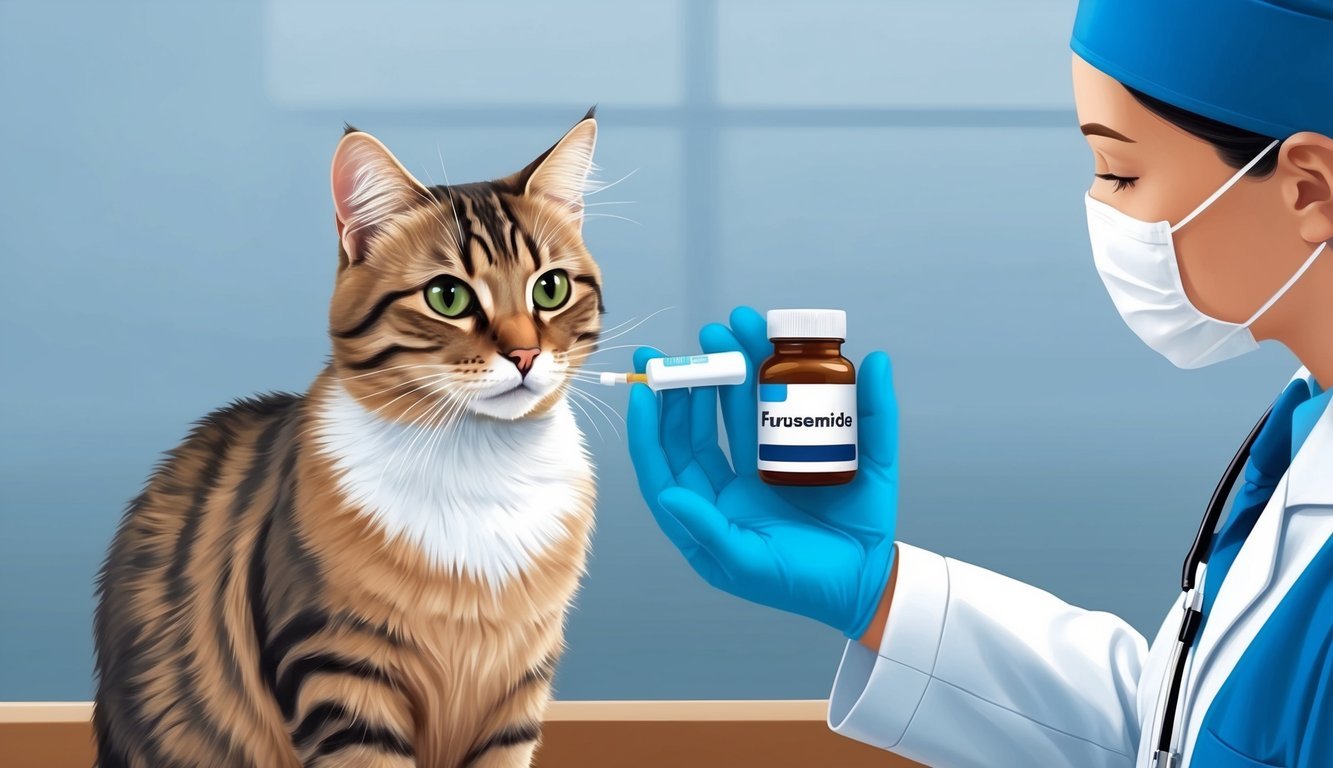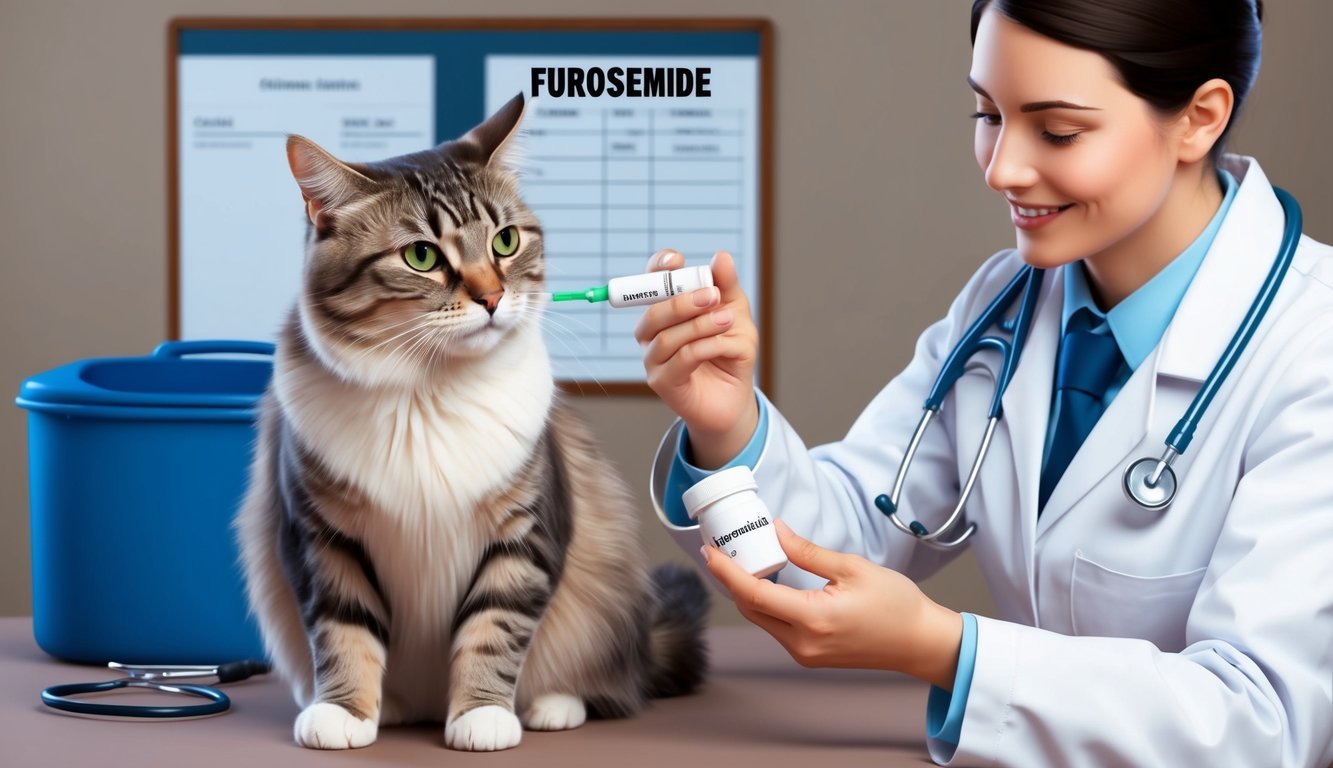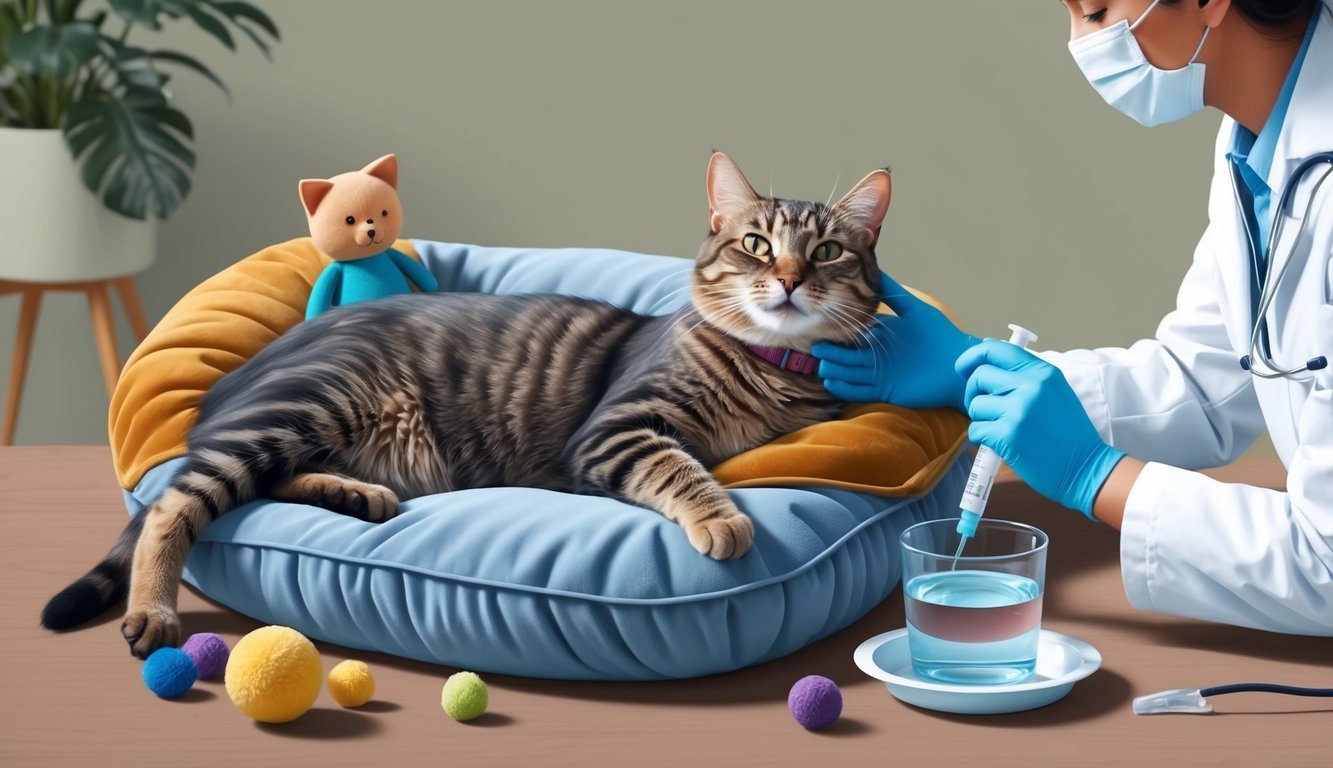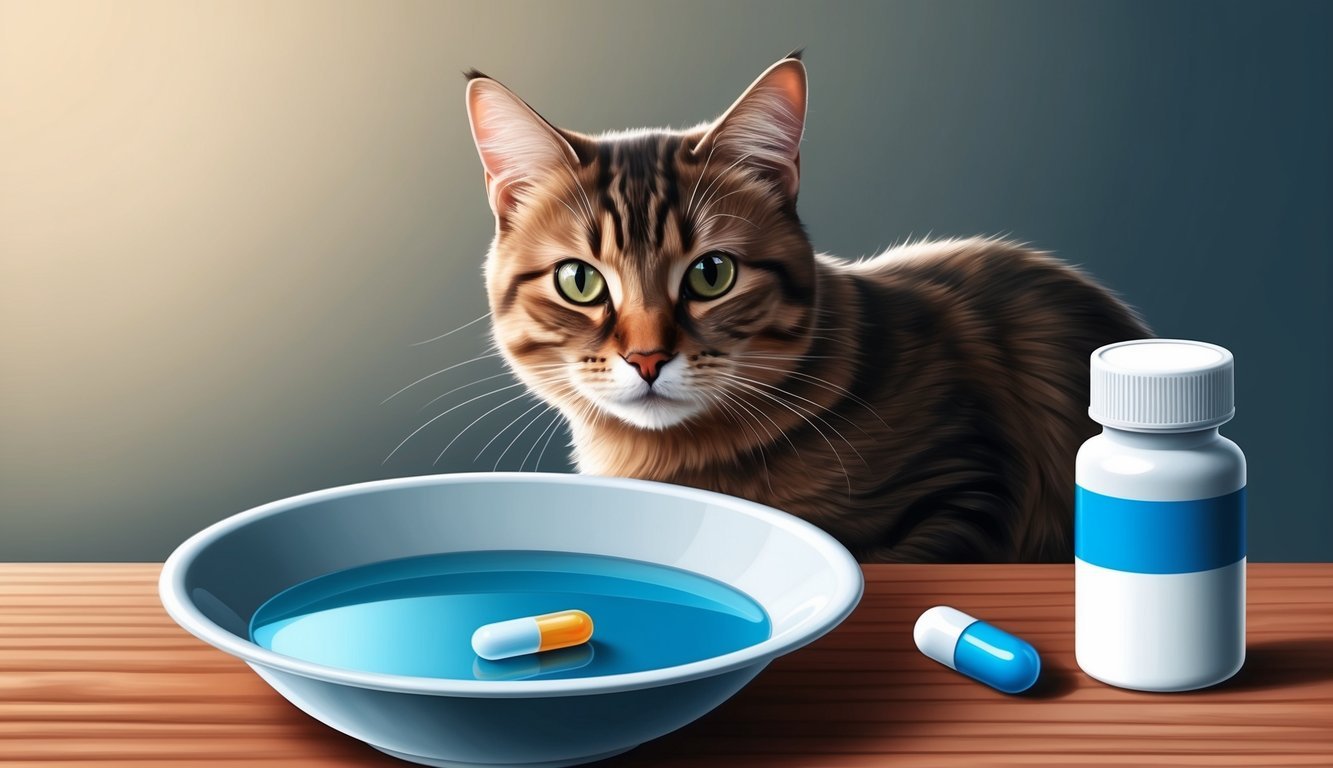Furosemide, commonly known for its effectiveness as a diuretic, plays a crucial role in managing health issues in cats.
Understanding how this medication works can significantly improve your feline friend’s quality of life, especially if they are facing conditions like congestive heart failure or pulmonary edema.
It’s important to know how to administer it properly and recognize potential side effects.
As a responsible pet owner, ensuring your cat’s health is a top priority.
Furosemide can help eliminate excess fluid and alleviate symptoms of various ailments, but it must be used with care under veterinary guidance.
Being informed about the dosages, frequency, and monitoring can make a real difference in your cat’s well-being.
In this article, you’ll learn not just about the right way to use furosemide but also about vital considerations that might impact your cat’s health.
Knowing what to expect can prepare you for a smoother journey in managing your pet’s health care.
Key Takeaways
- Furosemide is essential for treating certain health conditions in cats.
- Administering the right dosage while monitoring effects is crucial.
- Awareness of side effects leads to better health management for your cat.
Understanding Furosemide

Furosemide is a widely used medication in both human and veterinary medicine.
It’s crucial to grasp what it is, how it functions as a loop diuretic, and its applications in treating cats.
What Is Furosemide?
Furosemide, commonly known by brand names such as Lasix and Salix, is a diuretic medication.
It assists in the removal of excess fluid from the body, making it essential for treating conditions like congestive heart failure.
The medication enhances urine production, which helps reduce fluid accumulation in various organs.
When administered to cats, it is typically given orally.
Dosing varies based on the cat’s specific health issues and body weight.
You should always follow your veterinarian’s recommendations regarding the appropriate dosage and frequency.
Role as a Loop Diuretic
As a loop diuretic, furosemide operates on the loop of Henle in the kidneys.
This area of the kidney is crucial for reabsorbing sodium and water.
When furosemide is present, it inhibits this reabsorption, leading to increased urination.
This mechanism is particularly effective in alleviating symptoms associated with fluid overload.
In cats, this can be especially helpful for those with heart conditions.
Increased urine output helps relieve pressure on the heart and lungs, thus promoting better overall organ function.
Furosemide and Veterinary Use
In veterinary medicine, furosemide is vital for managing conditions like congestive heart failure and pulmonary edema in cats.
Dosages typically range from 1 to 4 mg per kilogram of body weight, given once or twice daily.
Your veterinarian will assess the severity of your cat’s illness to determine the correct dose.
Watching closely for side effects is important, as improper use can lead to dehydration or electrolyte imbalances.
Regular veterinary check-ups are crucial while your cat is on furosemide therapy to monitor its health and adjust medication as necessary.
Medical Considerations for Cats

When using furosemide for your cat, it’s essential to understand when it is prescribed, potential drug interactions, and its role in treating specific conditions like congestive heart failure.
Here are some critical details to keep in mind.
When Is Furosemide Prescribed?
Furosemide is commonly prescribed when a cat is experiencing fluid retention due to conditions such as heart disease or hypertension.
For example, in cases of congestive heart failure (CHF) or hypertrophic cardiomyopathy, it helps reduce the excess fluid that can accumulate in the lungs or abdomen.
Your veterinarian may also recommend furosemide when managing pulmonary edema or other illnesses requiring fluid management.
It’s important to follow the prescribed dosage, typically around 2mg/kg, as frequent adjustments can lead to complications.
Monitoring your cat’s symptoms is crucial to ensure the medication is effective and safe.
Potential Drug Interactions
Furosemide can interact with several other medications, which is something to discuss with your vet.
Drugs like NSAIDs, certain antibiotics, and ACE inhibitors can exacerbate or mitigate the effects of furosemide.
These interactions may lead to increased risks of side effects or decreased efficacy.
Monitor your cat closely for changes in behavior or health when starting furosemide alongside other medications.
Reporting any unexpected symptoms can help your vet adjust the treatment plan effectively to ensure your cat’s safety and well-being.
Furosemide in Congestive Heart Failure
For cats suffering from CHF, furosemide plays a vital role in management.
It works by promoting urinary excretion of excess fluids, which reduces the workload on the heart.
This is especially critical for improving breathing and overall quality of life.
You may notice that your cat’s appetite and energy levels improve as the fluid accumulation decreases.
Regular veterinary check-ups are essential to monitor kidney function and electrolyte levels, as furosemide can lead to imbalances.
Your vet will guide you on the best practices to ensure your cat stays healthy while undergoing treatment.
Administering Furosemide
When administering furosemide to your cat, it’s crucial to understand the proper dosage and administration techniques, how to monitor your cat’s response, and why ongoing veterinarian guidance is essential.
This medication can be highly effective, but it needs careful management.
Dosage and Administration
Furosemide is typically prescribed in either oral or injectable forms.
The dosage may vary, but a common starting point for cats is 0.5 to 2 mg/kg, given every 1 to 8 hours based on their condition.
It’s essential to follow your veterinarian’s instructions precisely.
When giving the medication:
- Oral tablets can be placed directly in your cat’s mouth or mixed with food.
- Injectable forms are often administered by a vet or can be given at home in some cases.
Always ensure your cat stays hydrated, as this medication is a diuretic and increases urine output.
Monitoring and Adjustments
Monitoring your cat while they are on furosemide is crucial to ensure the medication is effective and safe.
Regular blood tests can assess kidney function and electrolyte levels, which furosemide can impact.
Signs to watch for include:
- Increased thirst or urination.
- Changes in appetite or behavior.
- Symptoms of dehydration, like lethargy or dry gums.
Your veterinarian may adjust the dosage based on these indicators.
Frequent follow-up appointments are recommended, especially when starting or modifying treatment.
Importance of Veterinarian Guidance
It’s vital to maintain open communication with your veterinarian throughout the treatment process.
Furosemide is a prescription medication, and your vet will provide personalized advice based on your cat’s health status.
Your vet will guide you on:
- Assessing the therapeutic effect of furosemide.
- Performing necessary blood tests to monitor kidney function.
- Making adjustments based on your cat’s unique needs.
Always consult your veterinarian before making any changes to the medication regimen.
Proper management ensures your cat receives the best possible care while on furosemide.
Possible Side Effects

When using furosemide for your cat, it’s crucial to be aware of potential side effects.
This medication can impact various bodily functions, and recognizing these can help you act quickly if needed.
Common Adverse Reactions
Furosemide can lead to a range of side effects.
Some of the most common include:
- Increased Thirst: Your cat may drink more water than usual, which can lead to increased urination.
- Increased Urination: You might notice your cat needing to go outside or to the litter box frequently.
- Dehydration: Excessive urination can cause dehydration if your cat doesn’t compensate with water intake.
- Electrolyte Imbalance: This can occur from the loss of essential salts, which may lead to further complications.
- Gastrointestinal Issues: Vomiting or diarrhea could occur as the body reacts to the medication.
It’s vital to monitor your cat for these symptoms closely after starting furosemide.
Managing Side Effects
If your cat exhibits side effects, there are steps you can take to help manage them:
- Hydration: Ensure your cat has constant access to fresh water. This can help combat dehydration and excessive thirst.
- Diet: Consider discussing a diet that supports electrolyte balance with your veterinarian. Some diets are tailored for cats on diuretics.
- Regular Check-ups: Schedule follow-up appointments with your vet to monitor electrolyte levels and overall health.
- Medication Review: If side effects persist, talk to your vet about adjusting the dosage or switching medications.
Prompt action can help mitigate the risks associated with these side effects.
Recognizing Signs of Overdose
Overdose of furosemide can be serious and requires immediate attention.
Here are signs to watch for:
- Extreme Dehydration: Look for symptoms like lethargy, dry gums, or sunken eyes.
- Severe Electrolyte Imbalances: Muscle tremors, weakness, and irregular heartbeats may indicate a critical situation.
- Persistent Vomiting or Diarrhea: If your cat shows these symptoms beyond the usual range, it could signify overdose.
- Behavioral Changes: Increased agitation or confusion may occur with overdose.
If you suspect an overdose, contact your veterinarian or an emergency animal clinic right away.
Your quick response can make a significant difference.
Additional Health Considerations

When using furosemide for your cat, it’s important to consider how it impacts hydration, kidney health, and electrolyte balance.
Monitoring these aspects can help ensure your feline remains healthy while on this medication.
Hydration and Kidney Health
Furosemide works as a diuretic, which means it increases urine production.
This can lead to dehydration if not properly managed.
Ensure your cat always has access to fresh water, as increased thirst is common.
If your cat has pre-existing kidney disease, furosemide can exacerbate the condition by further increasing fluid loss.
Regular veterinary check-ups and urine tests are crucial to monitor kidney function.
Look for signs of dehydration such as dry gums or decreased skin elasticity.
Electrolyte Balance and Monitoring
Furosemide can lead to electrolyte imbalances, particularly low potassium levels, which is known as hypokalemia.
This condition can cause muscle weakness, lethargy, and in severe cases, heart problems.
Regular blood tests are essential to monitor electrolyte levels while your cat is on furosemide.
Be attentive to any unusual behavior or symptoms, such as weakness or changes in appetite, as these can indicate an imbalance that needs immediate attention.
Interactions with Other Conditions
If your cat has diabetes mellitus or other underlying health issues, it’s vital to discuss furosemide use with your veterinarian.
The diuretic action can complicate management of diabetes, making glucose control more challenging.
It’s important to adjust dietary needs as well.
Ensuring a balanced diet can help mitigate some risks associated with medications like furosemide.
Always consult your vet when changes in your cat’s health occur.
Improving Quality of Life

Furosemide plays a crucial role in enhancing the quality of life for cats with conditions like congestive heart failure (CHF).
By effectively managing symptoms and providing supportive care, you can better ensure your cat remains comfortable and happy.
Furosemide Therapy Goals
The primary goals of furosemide therapy include reducing fluid buildup in the lungs and abdomen, alleviating symptoms of CHF, and improving your cat’s overall well-being.
Administering furosemide can help:
- Relieve Coughing: Excess fluid often leads to coughing, but furosemide can help reduce this.
- Improve Breathing: Less congestion means your cat can breathe comfortably.
- Promote Activity: With improved comfort, your cat may be more willing to engage and play.
Regular monitoring of kidney values is essential, as furosemide can impact renal function.
It’s critical to work closely with your veterinarian to tailor the treatment to your cat’s specific needs.
Supportive Care Beyond Medication
Medication alone isn’t enough; supportive care is vital to improving your cat’s quality of life.
Consider these approaches:
- Hydration: Ensure your cat has constant access to fresh water, as furosemide increases urination.
- Diet Management: A low-sodium diet can complement furosemide therapy and help manage fluid retention.
- Comfortable Environment: Maintain a calm and cozy living space, allowing your cat to rest and relax without stress.
Regular check-ups with your vet can help adjust treatment plans and make necessary changes to improve comfort.
Evaluating Treatment Success
Evaluating the effectiveness of furosemide involves observing several factors.
Keep an eye on:
- Symptom Improvement: Look for reduced coughing and better energy levels.
- Weight Monitoring: Sudden weight changes may indicate fluid retention or loss; discuss these with your veterinarian.
- Kidney Values: Regular blood tests will help determine if furosemide is affecting kidney health.
By tracking these aspects, you can assess whether the therapy is meeting its goals and make informed decisions regarding ongoing care.
Collaborating with your veterinarian will ensure the best possible outcome for your feline friend.
Frequently Asked Questions

When it comes to furosemide for your cat, you might have some common questions about its usage, dosage, and potential side effects.
Here’s a guide to help clarify those concerns.
What dosage of furosemide is generally considered safe for cats?
The safe dosage for furosemide in cats typically ranges from 1 mg to 4 mg per kilogram of body weight.
It’s best to administer this once or twice daily, but always consult your veterinarian for guidance tailored to your cat’s specific condition.
Are there any common side effects associated with administering furosemide to felines?
Yes, while many cats tolerate furosemide well, some common side effects include increased thirst, increased urination, and changes in appetite.
Monitoring your cat for these effects can help you manage any issues that arise.
How frequently should furosemide be given to a cat with a heart condition?
For cats with heart conditions, furosemide is often given once or twice daily.
The frequency can depend on your cat’s specific needs and how well they respond to the treatment, so follow your veterinarian’s recommendations closely.
Is there a risk of kidney damage when treating a cat with furosemide?
Furosemide can potentially cause changes in kidney function, especially if not dosed properly.
Regular veterinary check-ups are essential to monitor your cat’s kidney health while on this medication.
Can administering furosemide to a cat result in increased thirst or dehydration?
Yes, furosemide is a diuretic, which means it encourages increased urination and can lead to dehydration.
It’s important to ensure your cat has constant access to fresh water to help counteract this effect.
What are the signs that a cat might be overdosing on furosemide?
An overdose may cause excessive vomiting, diarrhea, weakness, or lethargy.
If you suspect your cat might have had too much furosemide, contact your veterinarian immediately.

